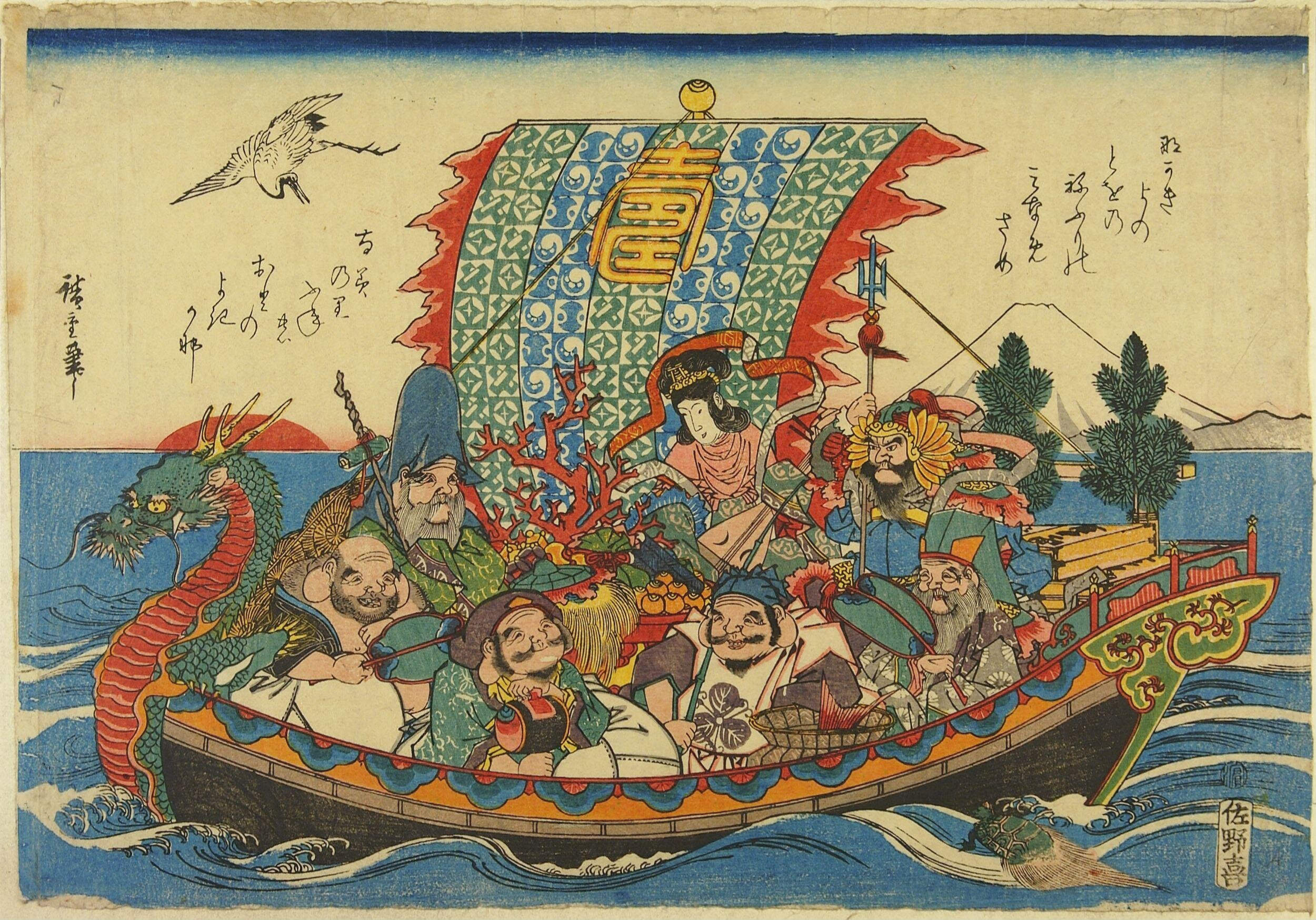Takarabune By Hiroshige on:
[Wikipedia]
[Google]
[Amazon]
 In
In
 In
In Japanese folklore
Japanese folklore encompasses the informally learned folk traditions of Japan and the Japanese people as expressed in its oral traditions, customs, and material culture.
In Japanese, the term is used to describe folklore. The academic study ...
, the ''Takarabune'' (), or "Treasure Ship", is a mythical ship piloted through the heavens by the Seven Lucky Gods
In Japanese mythology, the Seven Lucky Gods or Seven Gods of Fortune (, shichifukujin in Japanese) are believed to grant good luck and are often represented in netsuke and in artworks. One of the seven (Jurōjin) is said to be based on a historic ...
during the first three days of the New Year
New Year is the time or day currently at which a new calendar year begins and the calendar's year count increments by one. Many cultures celebrate the event in some manner. In the Gregorian calendar, the most widely used calendar system to ...
. A picture of the ship forms an essential part of traditional Japanese
Japanese may refer to:
* Something from or related to Japan, an island country in East Asia
* Japanese language, spoken mainly in Japan
* Japanese people, the ethnic group that identifies with Japan through ancestry or culture
** Japanese diaspor ...
New Year celebrations.
The ship
During the first three days of the New Year the Seven Lucky Gods are said to pilot through the heavens and into human ports a mythical ship called the ''Takarabune'', or "Treasure Ship". The gods carry with them ''takaramono'' (), or treasure things, including the , , the inexhaustible purse ( ''kanebukuro''), the secret keys to the treasure shed of the gods ( ''kagi''), the scrolls of books of wisdom and life ( ''makimono''), the magic mallet ( ''kozuchi''), the , the , and the bag of fortune ( ''nunobukuro'').Woodblock prints
A picture of the ship forms an essential part of traditionalJapanese
Japanese may refer to:
* Something from or related to Japan, an island country in East Asia
* Japanese language, spoken mainly in Japan
* Japanese people, the ethnic group that identifies with Japan through ancestry or culture
** Japanese diaspor ...
New Year celebrations. According to custom, placing a ''Takarabune'' woodblock print
Woodblock printing or block printing is a technique for printing text, images or patterns used widely throughout East Asia and originating in China in antiquity as a method of printing on textiles and later paper. Each page or image is create ...
beneath a pillow on the night of 2 January may induce a lucky dream – a sign that the year to come will be fortunate. In the event of an unpleasant dream, the print may be disposed of by throwing it into a river.
The custom of putting a picture under the pillow started around the Muromachi period
The is a division of Japanese history running from approximately 1336 to 1573. The period marks the governance of the Muromachi or Ashikaga shogunate (''Muromachi bakufu'' or ''Ashikaga bakufu''), which was officially established in 1338 by t ...
. It was initially popular among the nobility, and spread to commoners during the later Edo period
The or is the period between 1603 and 1867 in the history of Japan, when Japan was under the rule of the Tokugawa shogunate and the country's 300 regional '' daimyo''. Emerging from the chaos of the Sengoku period, the Edo period was characteriz ...
. Street vendors sold cheap woodblock prints, intended for single use.
Many ''Takarabune'' prints show a crane above and a turtle below, representative of longevity and felicity, as well as a palindromic
A palindrome is a word, number, phrase, or other sequence of symbols that reads the same backwards as forwards, such as the words ''madam'' or ''racecar'', the date and time ''11/11/11 11:11,'' and the sentence: "A man, a plan, a canal – Panam ...
poem which tells of a long night in a boat. At dawn, the sound of waves is heard and smooth sailing seen ahead.
References
{{ReflistSee also
*Hatsuyume
In Japanese culture, a is the first dream one has in the new year. Traditionally, the contents of such a dream would foretell the luck of the dreamer in the ensuing year. In Japan, the night of December 31 was often passed without sleeping, so ...
Japanese folk religion
New Year celebrations
Mythological ships